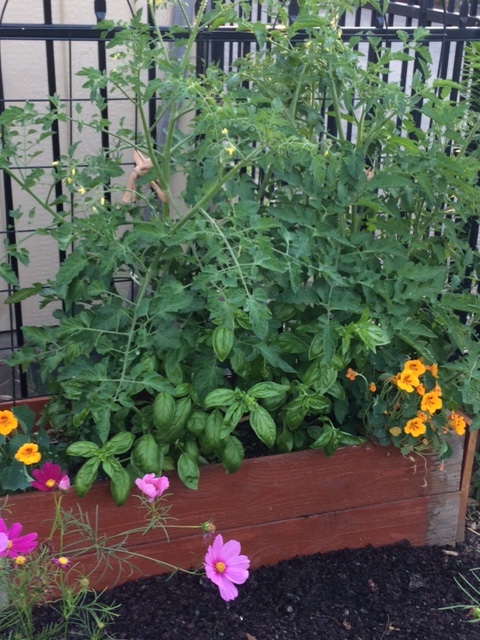One of my backyard gardens is on the site of a former garage. We removed the one-car garage last summer and replaced it with a larger building to store cars and tools. The site of the former garage is now where I grow vegetables in raised beds and am trying to grow some perennials, shrubs and vines on the extremely poor soil.
Raised beds can be a terrific way to grow vegetables, but as I am finding out, your beds are only as good as the soil in them. Witness the photo at left. The bed this sad tomato was planted in was one of two that were filled with a soil mix that was labeled as being specifically for raised beds, including those with vegetables. I planted beans, parsley, tomatoes, squash and marigolds in the two beds—in late May/early June. For weeks, they have sat there. And sat there.
With the exception of marigolds, which seemed to be growing a tiny bit and are flowering, none of the plants were thriving—or even growing much. On many of them, the leaves turned yellow. Nothing has up and died yet, but they sure have been struggling. Witness the photo below, a small raised bed (with less sun than other raised beds) where I used an organic bagged soil mix and some manure. These tomatoes and basil plants were roughly the same size as the ones in the other beds when they were planted a few weeks ago, yet they are growing, producing flowers and fruit and generally doing what a plant should do. (Update: Since I wrote this post a week or so ago, these tomatoes have grown so much I’ve had to lash their trellis to the fence.)

Planted in a bagged soil mix, these tomatoes have grown so much I’ve had to tie them to the trellis. Photo taken July 15.
So what’s up? It could be the plants have gotten too much water, but given the size of the beds and the dryness of the top 3 inches of the soil, I doubt that. I checked out this article on what yellow leaves on plants means and my yellow leaves don’t perfectly match any of the pictures—though they are close on a couple of them. A couple of weeks ago, in absolute frustration, I decided to add some more nitrogen to see if that helped. One bed got composted manure; the other got liquid fertilizer. The plants have grown more since then—one of the beans has finally latched onto the trellis I want it to climb and a few bean flowers have emerged.
I also sent a sample of the soil to the U of M Soil Testing Lab to find out exactly what kind of soil I’ve got here. (I contacted the landscaping firm that sold me the soil, but have not heard back from them.) The U turned around the soil test results quickly and I found out that while the mix had a good percentage of organic matter (12.5 percent), it had sky-high levels of potassium (that’s the K in the N-P-K ratio on most fertilizer bags.) Potassium’s main role in plant growth is to regulate how other nutrients are taken up by the plant and to regulate certain processes. Too much potassium in the soil will interfere with up-take of nutrients such as calcium and magnesium. The U recommended I add nitrogen but nothing else to the soil to improve plant growth.
One of the main reasons to grow vegetables in raised beds is that you can control the soil better. In my case, the dreadful soil that was already on the site made growing vegetables impossible without raised beds. If the beds are tall (mine are about 14 inches tall), they should be treated like a container, with regular watering and fertilizing to enrich the soil. Needless to say, come fall, I will be adding leaves, compost and manure to all my beds in hopes of getting the soil in better shape for next year.
Do you grow vegetables in raised beds? What’s your favorite soil mix?

It does seem impractical to request a soil test before buying large amounts of soil, but it’s a good idea. Several years ago, I had a truckload of topsoil delivered to my garden, and when the Autumn Gold sedum started getting smaller(!), the soil test revealed off-the-chart phosphorus. Luckily, most perennials tolerated it.
I use raised beds for vegetables and flowers, sitting on clay soil. Usually I top the beds off with horse manure mixed with sawdust/woodchips in the fall, but my source dried up. So this year I added a bag of composted cow manure and a bag of soil for raised beds to each bed. Like you, nothing much is happening. I had this problem last year as well, with organic potting soil. Thanks for suggesting what the problem may be. I was beginning to fear I had lost my green thumb.
One other thing that I’m thinking is part of my issue is the alkaline water we have in St. Paul. My raised beds (and everything else) has perked up a lot since we had about 1.5 inches of rain last week. Rain has a neutral pH of 5.6, while the water in St. Paul is close to 8. Always learning something.